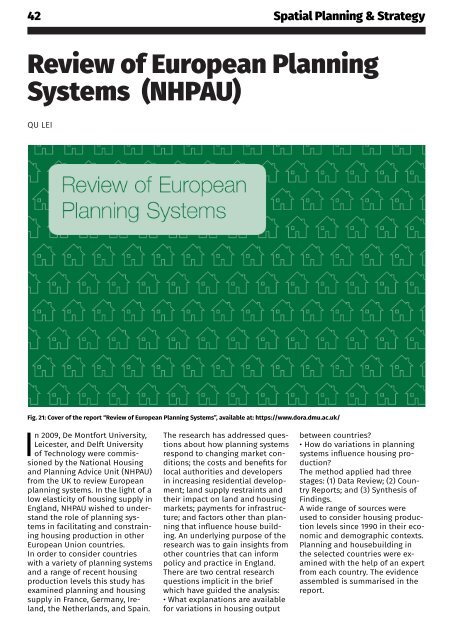*Celebrating Spatial Planning at TU Delft: 2008-2019. Edited by Stead, Bracken, Rooij & Rocco
This is a summary of the achievements of the session Spatial Planning & Strategy of the Department of Urbanism, Faculty of Architecture and the Built Environment, TU Delft, led by Professor Vincent Nadin between 2008 and 2019.
This is a summary of the achievements of the session Spatial Planning & Strategy of the Department of Urbanism, Faculty of Architecture and the Built Environment, TU Delft, led by Professor Vincent Nadin between 2008 and 2019.
You also want an ePaper? Increase the reach of your titles
YUMPU automatically turns print PDFs into web optimized ePapers that Google loves.
42 <strong>Sp<strong>at</strong>ial</strong> <strong>Planning</strong> & Str<strong>at</strong>egy<br />
Review of European <strong>Planning</strong><br />
Systems (NHPAU)<br />
QU LEI<br />
Fig. 21: Cover of the report “Review of European <strong>Planning</strong> Systems”, available <strong>at</strong>: https://www.dora.dmu.ac.uk/<br />
In 2009, De Montfort University,<br />
Leicester, and <strong>Delft</strong> University<br />
of Technology were commissioned<br />
<strong>by</strong> the N<strong>at</strong>ional Housing<br />
and <strong>Planning</strong> Advice Unit (NHPAU)<br />
from the UK to review European<br />
planning systems. In the light of a<br />
low elasticity of housing supply in<br />
England, NHPAU wished to understand<br />
the role of planning systems<br />
in facilit<strong>at</strong>ing and constraining<br />
housing production in other<br />
European Union countries.<br />
In order to consider countries<br />
with a variety of planning systems<br />
and a range of recent housing<br />
production levels this study has<br />
examined planning and housing<br />
supply in France, Germany, Ireland,<br />
the Netherlands, and Spain.<br />
The research has addressed questions<br />
about how planning systems<br />
respond to changing market conditions;<br />
the costs and benefits for<br />
local authorities and developers<br />
in increasing residential development;<br />
land supply restraints and<br />
their impact on land and housing<br />
markets; payments for infrastructure;<br />
and factors other than planning<br />
th<strong>at</strong> influence house building.<br />
An underlying purpose of the<br />
research was to gain insights from<br />
other countries th<strong>at</strong> can inform<br />
policy and practice in England.<br />
There are two central research<br />
questions implicit in the brief<br />
which have guided the analysis:<br />
• Wh<strong>at</strong> explan<strong>at</strong>ions are available<br />
for vari<strong>at</strong>ions in housing output<br />
between countries?<br />
• How do vari<strong>at</strong>ions in planning<br />
systems influence housing production?<br />
The method applied had three<br />
stages: (1) D<strong>at</strong>a Review; (2) Country<br />
Reports; and (3) Synthesis of<br />
Findings.<br />
A wide range of sources were<br />
used to consider housing production<br />
levels since 1990 in their economic<br />
and demographic contexts.<br />
<strong>Planning</strong> and housebuilding in<br />
the selected countries were examined<br />
with the help of an expert<br />
from each country. The evidence<br />
assembled is summarised in the<br />
report.




